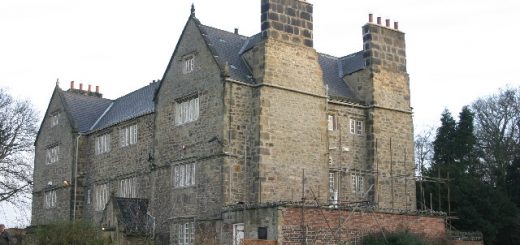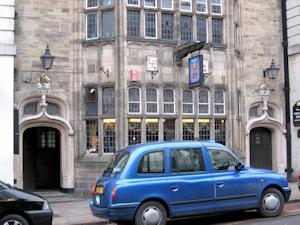Hampton Court Palace
Hampton Court Palace and St James’s Palace are the last two surviving palaces built by King Henry VIII. King Henry had acquired Hampton Court in 1525 when his Chief Minister, Thomas Wolsey, Arch Bishop of Canterbury fell from favour. Wolsey had spent seven years rebuilding the 14th century manor that would form the core of Henry’s new palace. Wolsey was allowed to stay at Hampton Court Palace until 1529.
 There are a few ghosts reported to reside at Hampton Court Palace. Catherine Howard (image left) (1521- 13th February 1542) fifth wife of Henry VIII is said to linger in the Haunted Gallery. She had an affair with Thomas Culpepper news of which reached the Royal Court. She was arrested at Hampton Court Palace is said to have been dragged screaming and pleading down the gallery in question to the apartments in which she was being held. She was taken to Traitors Gate at the Tower of London, driven past the severed heads of her previous lovers as they were displayed on spikes on London Bridge. Catherine was beheaded aged twenty-one on 13th February 1542 supposedly saying “I die a queen, but would rather die the wife of Culpepper.” Visitors to the gallery where reputedly Catherine has been seen and heard screams heard, have reported feeling uneasy and two ladies once fainted within an hour of each other at the same point place. Catherine is also said to haunt the Tower of London.
There are a few ghosts reported to reside at Hampton Court Palace. Catherine Howard (image left) (1521- 13th February 1542) fifth wife of Henry VIII is said to linger in the Haunted Gallery. She had an affair with Thomas Culpepper news of which reached the Royal Court. She was arrested at Hampton Court Palace is said to have been dragged screaming and pleading down the gallery in question to the apartments in which she was being held. She was taken to Traitors Gate at the Tower of London, driven past the severed heads of her previous lovers as they were displayed on spikes on London Bridge. Catherine was beheaded aged twenty-one on 13th February 1542 supposedly saying “I die a queen, but would rather die the wife of Culpepper.” Visitors to the gallery where reputedly Catherine has been seen and heard screams heard, have reported feeling uneasy and two ladies once fainted within an hour of each other at the same point place. Catherine is also said to haunt the Tower of London.
Dame Sybil Penn, nurse of Prince Edward (King Edward VI) and Princess Elizabeth (Queen Elizabeth I) died of small pox in 1562. She was buried at Hampton Church. The church was renovated in 1829 and her tomb moved. This is thought to have triggered the haunting of the Grey Lady who started to appear just after this event. She has been seen in the Clock Court, state apartments and other parts of the palace.
 The palace staircase is said to be haunted by Jane Seymour (image left) (1509 – 24 October 1537) third wife of King Henry VIII and mother to his only son King Edward VI. She was betrothed to Henry the day after Anne Boleyn was beheaded and married her 10 days later. Jane gave birth to Edward on 12 October 1537 at Hampton Court Palace and died there 12 days later of puerperal fever. She was buried in St Georges Chapel at Windsor Castle and when Henry himself died in 1547 he was buried beside her.
The palace staircase is said to be haunted by Jane Seymour (image left) (1509 – 24 October 1537) third wife of King Henry VIII and mother to his only son King Edward VI. She was betrothed to Henry the day after Anne Boleyn was beheaded and married her 10 days later. Jane gave birth to Edward on 12 October 1537 at Hampton Court Palace and died there 12 days later of puerperal fever. She was buried in St Georges Chapel at Windsor Castle and when Henry himself died in 1547 he was buried beside her.
In 2003 the ghosts of Hampton Court Palace attracted worldwide media interest after closed circuit television caught an interesting image. On the first day security officers were alerted to a fire door opening near the Introductory Exhibition which was caught on the security camera. On the second day the door opened again but a figure was also seen. “A ghostly-looking figure in period dress suddenly appeared on the screen and closed the doors”. A woman visiting the palace remarked on thinking she had seen a ghost in that area around the same time. The door opened again on the following day but no ghost was caught this time. A spokeswoman denied it was a hoax engineered by the palace which I believe. Whether what they caught was actually a ghost though is still subject to debate.




Re: Hampton Court Palace
Hampton Court (1897) by William Holden Hutton
One of the most interesting features of the chapel is the large royal pew, which forms the west gallery, and closely resembles the pew found in so many domestic chapels of great houses. It is approached through the "haunted gallery," down which It is said that Catherine Howard’s ghost still wanders, trying to intercept the King as he goes to the devotions which had so small an effect on his life.
Hampton Court belongs to-day not only to the present but to the mighty past. Still a royal palace, with its guard of honour, its chapel royal, its chaplain and choir, its staff of royal officials and servants, it has its close links with the past in the continuous occupation of many of its rooms by those who have borne their part, themselves or their kindred, in making England great. So we may walk through its courts with thronged memories of great names and from them we may pass to "thick-coming fancies" of a world invisible or half known. Imagination and tradition vie in bringing forth tales of strange noises and mysterious presences. That long room, now so grey and wan in the moonlight, that leads round the great kitchen-court from the great watching chamber to the top of the Queen’s staircase, bears the name of the Haunted Gallery. Was it here — for it opens into the Pages’ Chamber — that the Guards heard the sad, stern voice of Strafford give the countersign " Christ," as he passed by the sleeping pages and Mr. Inglesant on to where the King slept? Mr. Shorthouse may tell us that the vision was earlier and in another place; but Charles in those last days of his at Hampton must have had dark memories of the days that could not be recalled. Or is it Catherine Howard who tears herself from her guardians and runs shrieking to the door of the royal closet, that is in the west gallery of the chapel ? Henry sits stil! within at his prayers, and the door will not open, and the guard force her back; but her shrieks can still be heard above the storm on windy nights. It is locked, and we may not enter it at night ; but the custodian of the pictures, who has here some canvases that need his treatment, will not tell us that he has seen the vision of the White Lady who weeps and wrings her hands.
Or those two young cavaliers whose bones were found under the pavement of the cloister in the Fountain Court, and whose ghostly presence was felt in the rooms of a lady near ; do they now sleep well where they tie in Hampton Churchyard ? What tragedy lies behind their burying in the " Cloister Green " in hugger-mugger ?
Edward VI’s nurse, or Mistress [Sibell] Penn — not the "Mother Jak" (so labelled) of Holbein’s drawing, whom we now know to be Margaret Clement, Sir Thomas More’s adopted child — cannot she rest in peace in Hampton Church under her fine tomb
"Whose virtue guided hath her shippe unto the quiet rode?"
She died in 1562 of small-pox, and her body reposed, they tell you, till 1829, when the old church was destroyed. She then returned to the Palace, and worked her ancient spinning-wheel in a room that had remained concealed for two centuries. She walks, so say those who have seen her, in a "long grey robe with a hood over her head, and her lanky hands out-stretched before her;" and, like Hamlet’s father to the sentries " on their watch in the dead waist and middle of the night" she comes, and being challenged, passes into air.
Re: Hampton Court Palace
The following is from the Historic Royal Palaces website.
Near to Clock Court, Hampton Court Palace; On three consecutive days, palace security staff were called to close one particular fire door near the palace’s Introductory Exhibition.
On the first day, CCTV footage showed the doors flying wide open with great force but there was nothing to reveal why.
On the second day, the same thing happened but this time a ghostly-looking figure in period dress suddenly appeared on the screen and closed the doors.
The doors opened again on the third day but there was no further sign of the ghostly doorkeeper.
It wasn’t just security staff who thought they were seeing things. A visitor wrote in the palace’s visitor book on the second day that she too thought she had seen a ghost in that area.
CCTV footage of the figure caught the attention of the world’s media, with reports in newspapers and on TV and radio as far a field as India, Australia and Peru!
Catherine Howard is believed to frequent Hampton Court’s Haunted Gallery where she was dragged back screaming to her rooms while under house arrest, accused of committing adultery by her husband King Henry VIII.
Catherine was the fifth wife of King Henry VIII and in 1541 was accused of adultery and put under house arrest at the palace. But she escaped from her guards and ran down the gallery looking for the King to plead for her life.
She was caught and dragged back screaming to her rooms … and in due course executed at the Tower of London.
Anecdotal evidence
Grace-and-favour residents in neighbouring apartments have claimed to hear screams coming from the gallery.
Visitors today are often strangely affected in the gallery. On one evening in 1999, during separate tours of the palace, two female visitors fainted on exactly the same spot in the Haunted Gallery approximately half an hour apart.
So well known was Catherine’s story that, before the gallery was opened to the public in 1918, it was already called ‘The Haunted Gallery’.
Scientific evidence?
Psychologists from the University of Hertfordshire could not explain the eerie feelings of visitors following a week-long investigation in 2000.
They found, against their expectations, visitors’ experiences tended to occur in specific areas of the gallery.
‘I often walk down the Haunted Gallery and for some inexplicable reason feel as if something is not quite as it should be. Things do happen in the Haunted Gallery. I was being interviewed for a radio programme when for no apparent reason, the mini-disc machine switched itself off … and the journalist couldn’t explain it!’ – State Apartment Warder Ian Franklin